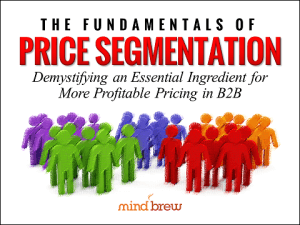If you’ve spent any time at all on PricingBrew, you know that we love price segmentation.
In a nutshell, price segmentation involves organizing your customers into groups based on how much they are willing to pay. For example, customers in an industry that is booming may be very concerned about delivery times and less concerned about price. On the other hand, customers in an industry that isn’t doing so hot might be a lot more price sensitive. By offering different prices to both groups, you can maximize your company’s revenue without scaring anyone off.
Simple, right?
But while price segmentation is an incredibly powerful tool (and really one of the most important in a pricing practitioner’s toolkit), it can be tough to put into practice. Yes, some of today’s software can do a lot of the work for you, but not everyone has access to that technology. And even with the right software, honing your price segmentation model requires a lot of knowledge and time.
What if we told you we know a shortcut?
With one very simple technique, you can get your customers to segment themselves. Instead of spending hours creating a pricing model — and then spending even more hours convincing sales to follow it — you can get your customers to do all the hard work for you.
What is this miracle technique, you ask?
It’s not rocket science. Just offer your customers choices.
Instead of presenting customers with one price quote, salespeople should offer a range of options. The actual options will differ depending on your particular product, but they might include different volume discounts, different bundles of complementary products, or prices that differ based on the delivery timeframe.
Offering these types of options has a ton of advantages:
- It frames the value that your product or service provides. If you just hand your prospect a quote, they don’t have any context to evaluate it. They might be comparing your offer to prices from other vendors that have very different levels of service. By providing options, you provide a framework for evaluating whether the various options are worth the price.
- It takes pressure off the salespeople. Before offering a quote, salespeople sometimes tie themselves in knots doing mental gymnastics to figure out how price sensitive a customer is. This approach eliminates the need for the sales team to exercise their dubious powers of psychoanalysis.
- It prompts the sales team to provide upsell and cross-sell opportunities. If you offer bundled products, the upsell and cross-sell opportunities are built right into the sales process. No one can forget to make the offer.
- It forces the customer to make a choice beyond a simple “yes” or “no.” If you’ve ever had a two-year-old, you know that a question like “Do you want to wear your red shirt?” is almost definitely going to provoke a loud “No!” and perhaps a full-on temper tantrum. On the other hand, a question like “Would you rather wear your red shirt or your blue shirt?” will probably get your toddler dressed and out the door (after she has changed her mind three times, of course). The same technique works on B2B sales prospects.
- It practically guarantees that the quote won’t be underpriced. By providing the customer with options, you’ve taken away the salesperson’s temptation to offer unearned discounts. And if you price appropriately, you’ll maximize your revenue no matter which option the customer selects.
If you’re struggling with your price segmentation model (or if you just don’t have the time and resources to create one right now), give this approach a try. At a minimum, getting your customers to self-segment can give you valuable data and insight that you can use to improve your pricing.
For more information on creating a sales proposal that gets results, check out our interview with Reuben Swartz on Creating More Powerful Sales Proposals. And if you haven’t watched it before, you should definitely see the webinar on The Fundamentals of Price Segmentation. It covers the key concepts and walks you through the segmentation process step by step.















